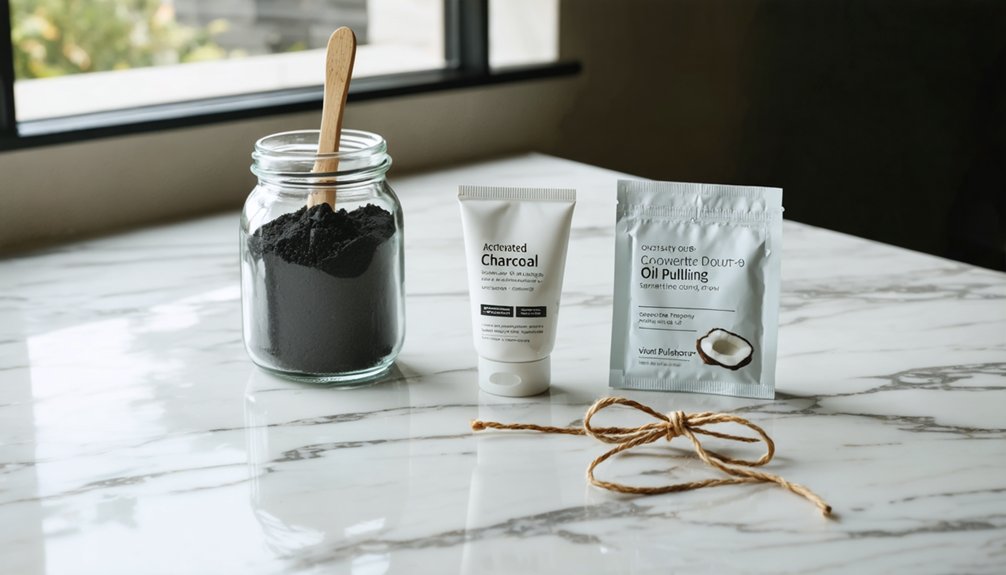If you have sensitive teeth, you’ll want to choose whitening products with lower peroxide concentrations and protective compounds like potassium nitrate and fluoride. Start with ADA-approved whitening toothpaste or gentle at-home kits containing 10-22% carbamide peroxide. Use desensitizing gel before treatment, maintain soft-bristled brushing, and avoid temperature extremes during the process. For best results while protecting your sensitive teeth, several key strategies can enhance your whitening journey.
Key Takeaways
- Choose whitening toothpaste with ADA approval containing low peroxide concentrations and protective ingredients like potassium nitrate and fluoride.
- Start with dentist-supervised at-home treatments using custom-fitted trays and lower-concentration gels for gentler whitening.
- Apply desensitizing gel before whitening treatments and use specialized desensitizing toothpaste between sessions.
- Brush with soft-bristled toothbrushes and avoid extreme temperature foods during the whitening process.
- Space out whitening sessions adequately to allow teeth recovery time and prevent heightened sensitivity.
Understanding Your Teeth Sensitivity Before Whitening
Why do some people experience tooth sensitivity while others don’t? The answer lies in your tooth structure and various risk factors. If you’ve noticed sharp, temporary pain when consuming hot, cold, or acidic items, you’re among the 12-50% of adults affected by tooth sensitivity.
Before pursuing whitening treatment, it’s essential to understand your sensitivity triggers and complete a thorough pain assessment. Consulting your dentist will help determine if you need a visual analog scale to properly evaluate your pain levels.
Sensitivity often occurs when your tooth’s protective enamel wears down or gums recede, exposing the dentin layer underneath. This exposure allows stimuli to affect the nerve endings through tiny tubules in the dentin. Recent studies show that dental erosion affects 98% of individuals with sensitivity issues.
When protective tooth enamel erodes, exposed dentin channels stimuli directly to sensitive nerve endings, causing discomfort and pain.
Common causes include aggressive brushing, grinding teeth, gum disease, and aging. Women and adults aged 38-47 are particularly susceptible, typically experiencing sensitivity in multiple teeth.
Safe Whitening Products for Delicate Smiles
Three key factors make safe whitening products essential for those with sensitive teeth: concentration, ingredients, and application method.
You’ll find that products specifically designed for sensitivity contain lower peroxide concentrations and protective compounds like potassium nitrate and fluoride to shield your enamel.
For ideal ingredient safety, choose ADA-approved whitening toothpastes or gentle at-home kits like Crest 3D White Whitestrips Gentle Routine. Strong whitening agents can intensify tooth discomfort and should be avoided.
Professional treatments offer customized solutions with precise peroxide levels and monitored application. Consulting a trusted dental provider helps ensure treatments are tailored to your sensitivity level.
If you’re seeking natural alternatives, consider ADA-approved baking soda toothpaste or carefully diluted hydrogen peroxide rinses.
However, always verify ingredient concentrations and follow application instructions strictly.
Remember that gentle, gradual whitening through consistent use of sensitivity-formulated products typically yields the best results while protecting your delicate dental tissue.
Professional Vs At-Home Treatment Options
When choosing between professional and at-home teeth whitening, you’ll need to weigh several clinical factors, including bleaching agent concentration, application method, and your teeth’s sensitivity level.
Professional whitening delivers dramatic results in a single visit using high-concentration gels (25-40% hydrogen peroxide), but it often causes significant tooth sensitivity. Dentists can activate stronger agents using ultraviolet light during in-office treatments. Experts recommend using products containing potassium nitrate to minimize discomfort during whitening procedures.
While the process may include light activation, studies show this doesn’t enhance results or reduce discomfort.
At-home kits, particularly custom-fitted trays with lower-concentration gels (10-22% carbamide peroxide), offer gentler whitening with minimal sensitivity.
Though results appear more gradually over 1-2 weeks, these systems can achieve comparable long-term outcomes.
For sensitive teeth, dentist-supervised at-home treatments typically provide the best balance of safety and effectiveness.
Protective Steps During the Whitening Process
Taking proper protective measures during teeth whitening greatly reduces sensitivity and optimizes results.
Smart preparation and protection during teeth whitening not only minimizes discomfort but also helps achieve the brightest, healthiest smile possible.
You’ll want to start using desensitizing gels and toothpaste containing potassium nitrate or arginine at least 10 days before treatment to block pain signals. Custom trays guarantee precise application while protecting your gums from whitening agents. Professional supervision ensures optimal safety protocols during the entire process.
During treatment, use a soft-bristled toothbrush and avoid extreme temperatures. Drink through a straw and stick to room-temperature foods and beverages for 48 hours post-treatment. The hydrogen peroxide exposure makes teeth temporarily more sensitive to temperature changes.
If you’re using at-home products, choose lower peroxide concentrations and follow application times strictly. Maintain regular fluoride rinses to strengthen enamel, and don’t hesitate to pause treatments if sensitivity occurs.
Remember to schedule adequate time between sessions to allow your teeth to recover properly.
Best Practices for Long-Term Whitening Success
Long-term whitening success builds upon proper protective measures through an extensive maintenance strategy. A thorough pre-treatment assessment helps identify potential sensitivity issues before they arise, while consistent post-treatment care guarantees lasting results. Calcium phosphate treatments can strengthen your enamel before beginning any whitening regimen. Professional whitening treatments provide the most dramatic results under expert supervision.
You’ll need to maintain regular dental check-ups to monitor your teeth’s response to whitening treatments and adjust your approach accordingly.
- Use specialized desensitizing toothpaste containing potassium nitrate to minimize discomfort between treatments
- Schedule periodic touch-up sessions at appropriate intervals to maintain your desired shade
- Monitor your consumption of staining substances and adjust your diet to protect your investment
When following these practices, you’ll achieve ideal whitening results while protecting your teeth’s health.
Combining professional guidance with proper maintenance techniques guarantees a balanced approach to achieving and maintaining your bright smile.
Frequently Asked Questions
Can I Whiten My Teeth While Wearing Braces or Dental Crowns?
You’ll face braces limitations since whitening won’t work evenly around brackets, and crown safety concerns exist because porcelain and resin materials don’t respond to bleaching. Wait until braces removal for best results.
How Long Should I Wait Between Whitening Treatments to Prevent Sensitivity?
You’ll need to wait 3-6 months between at-home whitening treatments and 6+ months for professional sessions. For ideal sensitivity management, space your whitening frequency based on your dentist’s personalized recommendations.
Will Tooth Whitening Affect Existing Dental Fillings or Bonding Materials?
Like a stone weathering rain, your filling materials and bonding won’t whiten with treatment. You’ll notice these restorations maintain their original shade while your natural teeth become lighter.
Does Taking Pain Relievers Before Whitening Help Reduce Sensitivity During Treatment?
Taking NSAIDs 30-60 minutes before whitening can help reduce sensitivity, though pain relief effectiveness varies between patients. For ideal timing considerations, you’ll want to continue medication throughout your treatment period.
Can Certain Medications or Medical Conditions Interfere With Teeth Whitening Results?
Yes, your medication effects and underlying health conditions can greatly impact whitening outcomes. You’ll find that tetracycline stains, dry mouth conditions, and certain antibiotics can reduce treatment effectiveness or require modified approaches.
References
- https://egglestondentalcare.com/best-teeth-whitening-for-sensitive-teeth/
- https://www.blvddentistry.com/can-you-get-whitening-treatment-with-sensitive-teeth/
- https://champagnedentalcare.com/teeth-whitening-for-sensitive-teeth-what-are-your-options/
- https://crest.com/en-us/oral-care-tips/teeth-whitening/teeth-whitening-sensitive-teeth
- https://www.sensodyne.com/en-us/oral-health-tips/whitening-sensitive-teeth/what-to-know/
- https://www.oxforddental.com/best-teeth-whitening-options-for-sensitive-teeth/
- http://www.goochlanddentistry.com/whats-the-best-teeth-whitener-for-sensitive-teeth/
- https://www.drbobsdentalcare.com/is-teeth-whitening-safe-for-sensitive-teeth/
- https://pmc.ncbi.nlm.nih.gov/articles/PMC3819160/
- https://pmc.ncbi.nlm.nih.gov/articles/PMC11326452/



